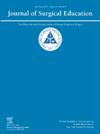有学位,就能旅行?地理位置与骨科住院医生匹配。
IF 2.6
3区 医学
Q1 EDUCATION, SCIENTIFIC DISCIPLINES
引用次数: 0
摘要
住院医师申请客观数据的缺乏是骨科住院医师项目在选择候选人进行面试和排名时面临的挑战。确定或量化地理位置对匹配结果的影响将有助于项目更有效地筛选和排名候选人。本研究的目的是描述当前美国骨科住院医师的地理背景,相对于他们目前的住院医师计划。我们假设住院医师的地理背景与其住院医师项目的地点之间存在显著的关系。方法:从骨科住院医师项目的公共网站获取美国骨科住院医师的地理背景信息。信息包括每位住院医师所在的地区和城市、家乡(HT)、本科(UG)学校和医学院(MS)。分析了居民规划区域与城市及其地理背景的关系。计算Cramer's V值来描述程序区与HT、UG和MS区之间的关联强度。程序到HT、UG市、MS市的距离采用哈弗辛距离公式计算。结果:纳入3718名美国骨科住院医师。47.2%的居民与他们的医生在同一地区匹配。在具有HT、UG和MS地区数据的居民中,36.6%的人参加了他们所在HT、UG学校和MS地区以外的项目。项目地区与HT、UG和MS地区之间存在统计学上显著的关系(p < 0.0001),其中与医学院地区的关系最强。居住项目距HT市平均距离1175 km,距UG市平均距离1041 km,距MS市平均距离894 km。在拥有HT, UG和MS城市数据的居民中,只有0.61%的人在其居住计划所在的同一城市,13.3%的人在其居住城市100公里范围内拥有HT, UG和MS城市。结论:骨科住院医师的地理历史与其住院医师项目所在地之间的关系是复杂的。大多数居民都居住在一个与他们有一定历史渊源的地方,但许多人居住的地方离他们的家乡和他们以前学习过的城市很远。这些信息可能对住院医师计划有所帮助,因为他们在考虑排名时权衡地理和其他因素的重要性。本文章由计算机程序翻译,如有差异,请以英文原文为准。
Have Degree, Will Travel? Geography and Orthopaedic Surgery Residency Match
INTRODUCTION
The paucity of objective data on the residency application is challenging to Orthopedic Surgery residency programs when selecting candidates to interview and to rank. Qualifying or quantifying the effect of geography on match results will help programs screen and rank candidates more effectively. The aim of this study is to describe the geographic background of current Orthopedic Surgery residents in the United States relative to their current residency program. We hypothesize there is a significant relationship between residents’ geographic background and the location of their residency programs.
METHODS
Geographic background information of current Orthopedic Surgery residents in the United States was obtained from public websites of Orthopedic Surgery residency programs. Information included region and city of each resident's residency program, hometown (HT), undergraduate (UG) school, and medical school (MS). The relationships between residents’ program region and city and their geographic background was analyzed. Cramer's V values were calculated to describe the strength of association between program region and HT, UG, and MS regions. Distance of program from HT, UG city, and MS city was calculated using the Haversine distance formula.
RESULTS
3718 US orthopedic residents were included. 47.2% of residents matched in the same region as their HT. 40.7% matched in the same region as their UG institution, and 49.6% matched in the same region as their MS. Of residents with data for HT, UG, and MS regions, 36.6% are in a program outside of the region of their HT, UG school, and MS. There was a statistically significant relationship between program region and HT, UG, and MS regions (p < 0.0001) with the strongest relationship seen with medical school region.
The average distance of residency program from HT was 1175 km, from UG city was 1041 km, and from MS city was 894 km. Of residents with data for HT, UG, and MS cities, only 0.61% had all 3 in the same city as their residency program, and 13.3% had HT, UG city, and MS city within 100 km of their residency city.
CONCLUSION
The association between the geographic history of Orthopedic Surgery residents and their residency program location is complex. Most residents are in residency in a location with which they have some history, but many live a considerable distance from their hometowns and the cities in which they have previously studied. This information may be helpful to residency programs as they weigh the importance of geography with other factors when considering their rank lists.
求助全文
通过发布文献求助,成功后即可免费获取论文全文。
去求助
来源期刊

Journal of Surgical Education
EDUCATION, SCIENTIFIC DISCIPLINES-SURGERY
CiteScore
5.60
自引率
10.30%
发文量
261
审稿时长
48 days
期刊介绍:
The Journal of Surgical Education (JSE) is dedicated to advancing the field of surgical education through original research. The journal publishes research articles in all surgical disciplines on topics relative to the education of surgical students, residents, and fellows, as well as practicing surgeons. Our readers look to JSE for timely, innovative research findings from the international surgical education community. As the official journal of the Association of Program Directors in Surgery (APDS), JSE publishes the proceedings of the annual APDS meeting held during Surgery Education Week.
 求助内容:
求助内容: 应助结果提醒方式:
应助结果提醒方式:


